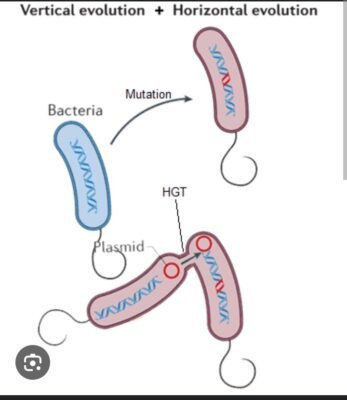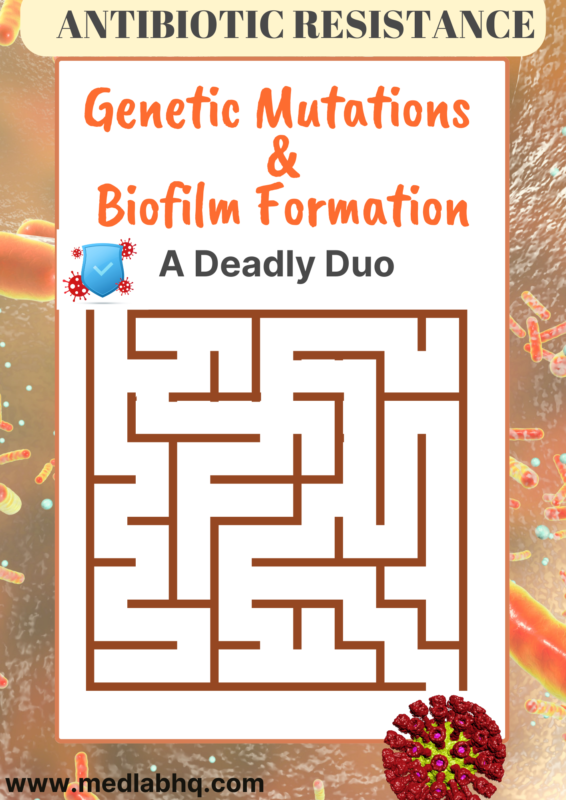Table of Contents
Introduction
Antibiotic resistance is one of the greatest challenges facing modern healthcare. As more bacteria develop resistance to commonly used antibiotics, treatment options dwindle, leading to longer hospital stays, higher medical costs, and increased mortality.
Two major factors contributing to this problem are genetic mutations and biofilm formation.
But what do these terms really mean in the context of antibiotic resistance? Let’s break it down into simple terms and look at how both genetic mutations and biofilms work together to protect bacteria.
What Are Genetic Mutations?
At its core, a genetic mutation is simply a change in the DNA of bacteria. Sometimes these changes happen by chance, but in other cases, bacteria adapt in response to their environment, especially when they are exposed to antibiotics. When antibiotics are overused or misused, bacteria are pushed to evolve and adapt.
The bacteria that survive, pass on their resistant traits to future generations. Over time, these resistant bacteria become more common, making it harder for antibiotics to do their job.
In a medical laboratory, this resistance can be spotted during culture and sensitivity testing. When a bacterial sample is cultured, we sometimes find that certain strains are no longer affected by standard antibiotics, a clear sign that mutations have occurred. These resistant strains can multiply rapidly and make infections much harder to treat.
Lets explore the various changes that occur during mutation
- Enzymatic Degradation: Some bacteria produce enzymes that break down or modify antibiotics. For example, bacteria like E. coli, Staphylococcus aureus (MRSA), Klebsiella pneumonia, Pseudomonas aeruginosa, produce beta-lactamases which break down beta-lactam antibiotics such as penicillins and cephalosporins.
- Altered Target Sites: Bacteria modify the antibiotic’s target site, so that the antibiotic cannot bind effectively. This can be seen in some strains Staphylococcus aureus (MRSA), which has altered penicillin-binding proteins (PBP). These Proteins are the enzymes involved in cell wall synthesis and are the target site for the B- lactam antibiotics. In its absence that antibiotic cannot be effective.
- Efflux Pumps: Some Bacteria have efflux pumps, they are membrane proteins that actively expel antibiotics out of the cell, reducing the drug’s concentration- sounds like magic right? Some can pump out multiple drugs while some are specific pumps. Example: Pseudomonas aeruginosa is popular for overexpressing efflux pumps to resist fluoroquinolone antibiotic like ciprofloxacin.
- Reduced Permeability: Changes in the bacterial cell membrane or wall reduce the drug’s ability to enter the cell.
What is Biofilm Formation?
Biofilm formation adds another layer of complexity. Biofilms are like protective shields that bacteria build around themselves, allowing them to stick to surfaces like medical devices, tissues, and even your teeth (ever wonder why plaque is so stubborn?).
These biofilms protect bacteria from both the immune system and antibiotics.
When bacteria are enclosed in a biofilm, it’s much harder for antibiotics to reach them. The biofilm acts as a barrier, slowing the penetration of the drugs and giving the bacteria inside more time to adapt and resist.
This process makes infections, especially in places like surgical wounds, catheters, or the lungs (in the case of diseases like cystic fibrosis), incredibly difficult to manage.
In the laboratory, biofilms are notorious for complicating testing. For example, standard antibiotic sensitivity tests may not always reflect the real-life challenge of treating a biofilm-associated infection.
This is because the bacteria behave differently inside the biofilm compared to free-floating bacteria in a liquid culture.
Here’s how biofilm formation contributes to antibiotic resistance:
- Physical Barrier: The biofilm matrix acts as a physical barrier, preventing antibiotics from reaching the bacteria within the biofilm.
- Slow Diffusion: The matrix creates a diffusion barrier, slowing down the movement of antibiotics through the biofilm. This allows bacteria to degrade or pump out the antibiotic before it reaches lethal concentrations.
- Persister Cells: Within biofilms, a small population of bacteria known as “persister cells” can enter a dormant state. These cells are less susceptible to antibiotics and can survive treatment, leading to recurrent infections.
- Horizontal Gene Transfer: Biofilms facilitate the exchange of genetic material between bacteria. This can lead to the spread of antibiotic resistance genes, making entire populations of bacteria more resistant.

Horizontal Gene Transfer (HGT) of antibiotic resistance
Examples of Biofilm-Forming Bacteria:
Pseudomonas aeruginosa: This bacterium is a common cause of hospital-acquired infections and is known for its ability to form biofilms on medical devices.
Staphylococcus aureus: This bacterium can form biofilms on various surfaces, including medical implants and catheters.
Enterococcus species: These bacteria are often found in the intestines but can cause infections when they enter the bloodstream. They can form biofilms on medical devices and tissues.
The question at the end of the day is;
How Can We Combat This?
So, what’s the way forward? There’s no single solution, but a multi-faceted approach can make a difference
- Proper Use of Antibiotics: The overuse and misuse of antibiotics are major drivers of resistance. By ensuring that antibiotics are only used when necessary and in the right dosage, we can reduce the pressure on bacteria to evolve.
- Improved Testing Methods: Medical laboratories play a key role in identifying resistant strains early. Using advanced testing methods that account for both genetic mutations and biofilm formation can help in tailoring treatment strategies. For example, biofilm assays can provide more accurate results on the effectiveness of antibiotics in real-world conditions.
- New Treatment Strategies: Researchers are exploring new ways to fight resistant bacteria, including antibiotics that can break through biofilms, combination therapies, and even the use of bacteriophages (viruses that specifically target bacteria). These strategies offer hope, but it will take time before they become widely available.
- Biofilm Prevention: Preventing biofilms from forming in the first place can go a long way. In hospitals, this can involve using coatings on medical devices that repel bacteria, as well as ensuring that equipment is cleaned and sterilized regularly.
Conclusion
The battle against antibiotic resistance is far from over, but by understanding the roles of genetic mutations and biofilm formation, we can better prepare ourselves to face the challenges ahead. Medical professionals, including laboratory scientists, have a crucial role in this fight, from detecting resistant strains early to supporting research into new treatment methods. With a focused effort, we can stay one step ahead of bacteria and continue to provide effective care for patients
By understanding the mechanisms of biofilm formation and antibiotic resistance, researchers can develop new strategies to combat these challenges and improve patient outcomes.
References
- Factors Contributing to the Emergence of Resistance – NCBI https://www.ncbi.nlm.nih.gov/books/NBK97126/
- Laboratory strengthening efforts key to combat antimicrobial resistance https://researchfeatures.com/laboratory-strengthening-efforts-key-combat-antimicrobial-resistance/
- Antibiotic resistance | Research and Innovation – European Union https://projects.research-and-innovation.ec.europa.eu/en/horizon-magazine/antibiotic-resistance

